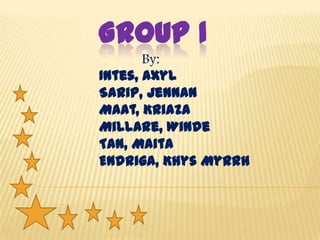
Properties and uses of alkali and alkaline earth metals
- 1. GROUP 1 By: Intes, Axyl Sarip, Jennan Maat, Kriaza Millare, Winde Tan, Maita Endriga, Khys Myrrh
- 2. ALKALI AND ALKALINE EARTH METALS are a group of chemical elements in the periodic table with very similar properties.
- 3. Li Be Na Mg K Ca Rb Sr Cs Ba Fr Ra ALKALI AND ALKALINE EARTH METALS
- 4. ALKALI METALS Found in group 1 of the periodic table (formerly known as group IA), Also called as active elements. Are very reactive metals that do not occur freely in nature. The alkali metals are softer than most other metals.
- 5. ALKALI METALS Properties of Alkali Metals: They are all soft, shiny, malleable, ductile, good conductors of heat and electricity , react vigorously with water and they have one electron in the highest (outermost )energy level. Therefore, they are ready to lose that one electron in ionic bonding with other elements. This group consists of the elements: Lithium (Li), Sodium (Na), Potassium (K), Rubidium (Rb), Cesium (Cs) and Francium (Fr).
- 6. ALKALI METALS Cesium and francium are the most reactive elements in this group. Alkali metals can explode if they are exposed to water.
- 7. LITHIUM (Li) – From Lithus , or stone. The lightest in weight of all metals. When alloyed with aluminum , finds great use in aircraft construction. DISCOVERY: 1817 by Johann A. Arfvedson of Sweden Uses: Lubricants, dry cells , storage batteries, glass and pharmaceuticals Lithium
- 8. SODIUM Sodium (Na) – From soda and natrium. Is a necessary constituent of plant and animal tissue. Pure sodium is poisonous and very corrosive. Discovery: 1807 by Sir Humphry Davy of Britain Uses: Salt, glass, metal purifier, soap, paper , textile.
- 9. POTASSIUM Potassium (K) - from potash and kalium . A constituent of all plant and animal tissue as well as of fertile soil. Although slighty radioactive. a prime element in fertilizers. DISCOVERY: 1807 by Sir Humphry Davy of Britain USES: Fertilizers; Heat transfer agent; “Strike anywhere” matches, fireworks, explosives
- 10. RUBIDIUM Rubidium(Rb) From rubidus or red. After Cesium it is the most active of the alkali metals; and the most widely distributed element. It is also found in small quantities tea, coffee, tobacco, and other plants. Discovery: 1860 by Robert Wilhelm Bunsen and Gustav Robert Kirchhoff of Germany USES: Gas scavenger in vacuum, photocell component, thermo electric generator
- 11. CESIUM Cesium (Cs) From caesius, or sky blue. It is the softest metal since it is liquid at room temperature ( 83 ℉) or (28 ℃) . The natural source producing the greatest quantity of cesium is the rare mineral pollux (or pollucite). DISCOVERY: 1860 by Bunsen and Kirchhoff of Germany Uses: Photoelectric cells, “Getter “ in electron tubes, atomic clocks.
- 12. FRANCIUM FRANCIUM (Fr) For France. The heaviest of the alkaline metals and the most electropositive element. Has never actually been seen since it is a short-lived product of the decay of actinium. DISCOVERY : 1939, by Marguerite Perey of France NO USES KNOWN
- 13. ALKALINE EARTH METALS Also called as Group II A elements. All alkaline earth elements have an oxidation number of +2, making them very reactive. Because of their reactivity, the alkaline earth metals are not found free in nature. Beryllium (Be), Calcium (Ca), Strontium (Sr), Barium (Ba) , and Radium (Ra)
- 14. BERYLLIUM Beryllium (Be) From the mineral beryl , an aluminum beryllium silicate. Although beryllium products are safe to use and handle, the fumes and dust released during fabrication are highly toxic. Discovery: 1797 by Louis Nicolas Vauquelin of France; First isolated in 1828 Friedrick Wohler and Antonine Alexandre Brutus Bussy USES: watch spring; space shuttle parts ; welding electrodes; x-ray tubes; computers; lasers; televisions ; oceanographic instruments.
- 15. MAGNESIUM MAGNESIUM (Mg) From Magnesia an ancient city in asia. Except Beryllium, Magnesium is the lightest metal that remains stable under ordinary conditions. It offers the greatest strength for weight among metals but readily corrodes. DISCOVERY: 1808 by Sir Humphry Davy of Britain USES: Bicycle parts, Bricks for furnaces, Medicine, Propellants.
- 16. CALCIUM Calcium (Ca) From calx, or lime. Calcium is a ductile and malleable metal. When exposed to the air it rapidly tarnish to yellow. It reacts violently with water ; forming the hydroxide and releasing hydrogen. Essential for teeth and bone development. DISCOVERY: 1808 by SIR DAVY of BRITAIN USES: Plaster of Paris , Deodorizer, Batteries; Portland cement , Medicine .
- 17. STRONTIUM STRONTIUM (Sr) From Strontian, Scotland. It has the reverse effect of Calcium on the body since radioactive strontium 90 can cause cancer., DISCOVERY: 1790 by Sir Davy of Britain USES: Fireworks, glass for TV Ferrite magnet.
- 18. BARIUM Barium (Ba) From Barys, heavy or dense. A highly reactive metal. Reacts vigorously with water and rapidly corroded by most air . DISCOVERY: 1808, by Sir Davy of Britain USES: Spark plugs , rubber , paint , glass, Xray, rat poison, fireworks.
- 19. RADIUM Radium (Ra) From Radius, or ray. Upon exposure to air the element oxidizes immediately . Emit alpha, beta, and gamma rays. DISCOVERY: 1898, by Pierre and Marie Curie of France USES: Radiation source, self-luminous paints, radiotherapy device.
- 20. MELTING AND BOILING POINTS OF ELEMENTS ALKALI METALS Melting Point (℃) Boiling Point (℉) 1342 Lithium 181 883 Sodium 98 760 Potassium 63 686 Rubidium 39 669 Cesium 28
- 21. MELTING AND BOILING POINTS OF ELEMENTS ALKALINE EARTH METALS Melting Point (K) Boiling Point (K) Beryllium 1562 2745 Magnesium 924 1363 Calcium 1124 1767 Strontium 1062 1655 Barium 1002 2078 Radium 973 (1973)(uncertain)
